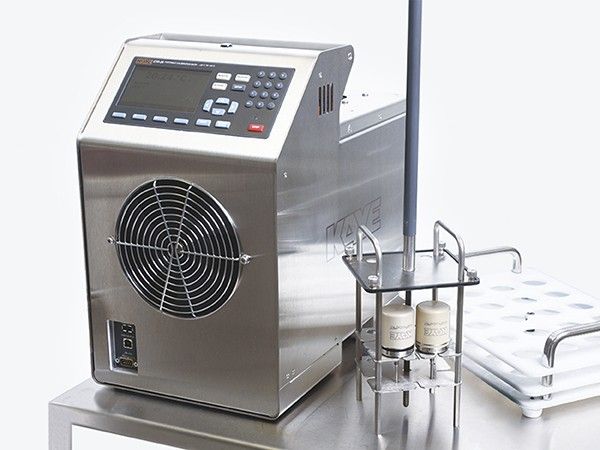Calibration is a crucial aspect of industrial processes, ensuring that instruments and devices perform accurately and reliably. Among the various calibration tools available, Dry Block Calibrator and Liquid Bath Calibrators stand out due to their precision and efficiency. This article delves into the features, applications, and benefits of these two essential calibration devices.
What is a Dry Block Calibrator?
A Dry Block Calibrator, also known as a dry-well calibrator, is a device used to calibrate temperature sensors and thermometers. It consists of a metal block with pre-drilled holes, each designed to hold a specific type of temperature sensor. The block is heated or cooled to a desired temperature, allowing the inserted sensors to be calibrated against a known and stable temperature source.
Key Features of Dry Block Calibrators
- Portability: One of the most significant advantages of Dry Block Calibrators is their portability. They are compact and lightweight, making them ideal for on-site calibration tasks.
- Rapid Heating and Cooling: Dry Block Calibrators can quickly reach and stabilize at the desired temperature, reducing downtime and increasing productivity.
- User-Friendly Interface: Modern Dry Block Calibrator come with intuitive interfaces, allowing users to set temperatures easily and monitor the calibration process.
Applications of Dry Block Calibrators
Dry Block Calibrators are widely used in industries where temperature measurement is critical. These include:
- Food and Beverage: Ensuring that cooking and storage temperatures are accurate to maintain food safety standards.
- Pharmaceuticals: Maintaining precise temperatures during the production and storage of medicines.
- HVAC: Verifying the accuracy of temperature sensors in heating, ventilation, and air conditioning systems.
What is a Liquid Bath Calibrator?
A Liquid Bath Calibrator, on the other hand, uses a liquid medium, usually oil or water, to create a stable temperature environment for sensor calibration. The sensors are immersed in the liquid, which is then heated or cooled to the desired temperature.
Key Features of Liquid Bath Calibrators
- High Stability: Liquid Bath Calibrators offer exceptional temperature stability due to the uniform heat distribution in the liquid medium.
- Wide Temperature Range: These calibrators can operate over a broader temperature range, making them suitable for calibrating a variety of temperature sensors.
- Accuracy: The immersion method used in Liquid Bath Calibrators ensures that the sensors are in direct contact with the medium, providing highly accurate calibration results.
Applications of Liquid Bath Calibrators
Liquid Bath Calibrator are preferred in scenarios where extreme accuracy and stability are required. Some common applications include:
- Calibration Laboratories: Ensuring that reference standards are maintained with high precision.
- Aerospace: Calibrating sensors used in critical applications such as aircraft engines and environmental control systems.
- Manufacturing: Verifying the accuracy of temperature sensors used in various manufacturing processes.
Comparing Dry Block Calibrators and Liquid Bath Calibrators
When deciding between a Dry Block Calibrator and a Liquid Bath Calibrator, several factors should be considered:
Accuracy and Stability
While both types of calibrators provide accurate results, Liquid Bath Calibrator generally offer higher stability and precision due to the uniform temperature distribution in the liquid medium. This makes them ideal for applications requiring stringent accuracy.
Portability
Dry Block Calibrators are more portable than Liquid Bath Calibrators. Their compact size and ease of use make them suitable for fieldwork and on-site calibration tasks. In contrast, Liquid Bath Calibrators are bulkier and better suited for laboratory environments.
Temperature Range
Liquid Bath Calibrators typically offer a wider temperature range compared to Dry Block Calibrator. This makes them versatile and capable of handling a broader array of calibration tasks.
Ease of Use
Dry Block Calibrators are generally easier to use, with straightforward interfaces and quick setup times. Liquid Bath Calibrator, while highly accurate, require more preparation and careful handling of the liquid medium.
Benefits of Using Dry Block Calibrators
- Cost-Effective: Dry Block Calibrators are often more affordable than their liquid bath counterparts, making them a cost-effective solution for many industries.
- Reduced Maintenance: With fewer moving parts and no liquid medium, Dry Block Calibrator require less maintenance and have a longer operational life.
- Safety: The absence of liquids eliminates the risk of spills and reduces safety hazards associated with handling hot or cold fluids.
Benefits of Using Liquid Bath Calibrators
- Superior Accuracy: The direct immersion of sensors in the liquid medium ensures higher accuracy and better repeatability of calibration results.
- Versatility: Liquid Bath Calibrators can handle a wide range of temperatures, making them suitable for various calibration needs.
- Comprehensive Calibration: They are ideal for calibrating sensors that require full immersion, providing more comprehensive calibration results.
Conclusion
Both Dry Block Calibrators and Liquid Bath Calibrator play vital roles in ensuring the accuracy and reliability of temperature measurement devices. The choice between the two depends on the specific needs of the application, considering factors such as accuracy, portability, temperature range, and ease of use.
Dry Block Calibrator are excellent for on-site calibrations, offering portability, ease of use, and cost-effectiveness. They are well-suited for industries such as food and beverage, pharmaceuticals, and HVAC, where quick and reliable calibration is essential.
On the other hand, Liquid Bath Calibrator provide superior accuracy and stability, making them ideal for applications demanding the highest precision. They are commonly used in calibration laboratories, aerospace, and manufacturing industries, where stringent standards must be met.
Ultimately, understanding the features and benefits of each type of calibrator will help you make an informed decision, ensuring that your temperature measurement instruments perform optimally and maintain the highest standards of accuracy and reliability.

